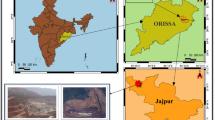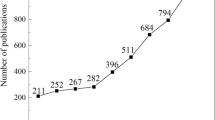Abstract
Many models have been widely used in landslide displacement prediction. However, few studies have proposed quantitative prediction formulas. Thus, the variational mode decomposition (VMD) theory was applied to decompose the “step-like” displacement of landslides into trend displacement, periodic displacement, and random displacement. Then, a novel prediction model based on wavelet analysis (WA) and a back-propagation neural network (BPNN) optimized by the grey wolf optimizer (GWO) algorithm was proposed (the GWO-BP model) to obtain a prediction formula. In this model, a polynomial function was first used to predict the trend displacement. All the hidden periods of periodic displacement were calculated using the WA method, and a trigonometric function was applied to predict the periodic displacement. In addition, based on an analysis of the grey relational degree (GRD), the main triggering factors, which can affect the random displacement, were determined. Then, the mathematical connection between random displacement and triggering factors was obtained with the GWO-BP model. Finally, all the predicted values were superposed to achieve the prediction cumulative displacement based on the time series model. The Outang landslide in the Three Gorges Reservoir area, China, was taken as an example, and the displacement data of monitoring sites MJ01 and MJ02 from December 2010 to December 2016 were selected for analysis. The results indicated that the root mean square errors (RMSE) between the real displacement values and the prediction values obtained using the formula were 14.79 mm and 12.59 mm, respectively. The correlation coefficient R values were 0.99 and 0.93, respectively. This model can be used to obtain the landslide displacement formula and provide a solid basis for developing early warning systems for landslides.
















Similar content being viewed by others
References
Cai Z, Xu W, Meng Y, Shi C, Wang R (2016) Prediction of landslide displacement based on GA-LSSVM with multiple factors. Bull Eng Geol Environ 75(2):637–646
Cao Y, Yin K, Alexander DE, Zhou C (2016) Using an extreme learning machine to predict displacement of step-like landslides in relation to controlling factors. Landslides 13(4):725–736
Casagli N, Catani F, Del Ventisette C, Luzi G (2010) Monitoring, prediction, and early warning using ground-based radar interferometry. Landslides 7(3):291–301
Deng D, Liang Y, Wang L, Wang C, Sun Z, Wang C, Dong M (2017) Displacement prediction method based on ensemble empirical mode decomposition and support vector machine regression- a case of landslides in Three Gorges Reservoir area. Chin J Rock Mech Eng 38(12):3660–3669
Deng J (1989) Introduction to grey system theory. J Grey Syst 1(1):1–24
Du J, Yin K, Chai B (2009) Study of displacement prediction model of landslide based on the response analysis of inducing factors. Chin J Rock Mech Eng 28(9):1783–1789
Du J, Yin K, Lacasse S (2013) Displacement prediction in colluvial landslides, Three Gorges Reservoir, China. Landslides 10(2):203–218
Dragomiretskiy K, Zosso D (2014) Variational mode decomposition. IEEE Trans Signal Process 62(3):531–544
Glade T, Anderson M, Crozier MJ (2005) Landslide hazard and risk: issues, concepts and approach. In: Landslide hazard and risk. Chichester: Wiley, pp 1-40
Grinsted A, Moore JC, Jevrejeva S (2004) Application of the cross wavelet transform and wavelet coherence to geophysical time series. Nonlinear Process Geophys 11(5/6):561–566
Guo Z, Yin K, Tang Y, Huang F, Fu X (2017) Stability evaluation and prediction of Maliulin landslide under reservoir water level decline and rainfall. Geol Sci Technol Inform 36(4):260–265
Guo Z, Yin K, Huang F, Liang X (2018) Landslide displacement prediction based on surface monitoring data and nonlinear time series combination model. Chin J Rock Mech Eng 37(Supp 1):3392–3399
Huang F, Yin K, Zhang G, Zhou C, Zhang J (2015) Landslide groundwater level time series prediction based on phase space reconstruction and wavelet analysis-support vector machine optimized by PSO algorithm. Earth Sci 40(7):1254–1264
Huang F, Yin K, Zhang G, Gui L, Yang B, Liu L (2016) Landslide displacement prediction using discrete wavelet transform and extreme learning machine based on chaos theory. Environ Earth Sci 75(20):1376–1393
Huang F, Huang J, Jiang S, Zhou C (2017) Landslide displacement prediction based on multivariate chaotic model and extreme learning machine. Eng Geol 218:173–186
Huang F, Yin K, Yang B, Li X, Liu L, Fu X, Li X (2018) Step-like displacement prediction of landslide based on time series decomposition and multivariate chaotic model. Earth Sci 43:887–898
Jia Y, Lv Q, Shang Y (2013) Rockburst prediction using particle swarm optimization algorithm and general regression neural network. Chin J Rock Mech Eng 32(2):343–348
Kirschbaum DB, Adler R, Yang H, Hill S, Lerner-Lam A (2010) A global landslide catalog for hazard applications: method, results, and limitations. Nat Hazards 52(3):561–575
Lee S, Ryu JH, Won JS, Park HJ (2004) Determination and application of the weights for landslide susceptibility mapping using an artificial neural network. Eng Geol 71(3-4):289–302
Li D, Yin K, Chin L (2010) Analysis of Baishuihe landslide influenced by the effects of reservoir water and rainfall. Environ Earth Sci 60(4):677–687
Li C, Tang H, Hu X, Li D, Hu B (2009) Landslide prediction based on wavelet analysis and cusp catastrophe. J Earth Sci 20(6):971–977
Li L, Wu Y, Miao F, Liao K, Zhang L (2018) Displacement prediction of landslides based on variational mode decomposition and GWO-MIC-SVR model. Chin J Rock Mech Eng 37(6):1395–1406
Lian C, Zeng Z, Yao W, Tang H (2013) Displacement prediction model of landslide based on a modified ensemble empirical mode decomposition and extreme learning machine. Nat Hazards 66(2):759–771
Lian C, Zeng Z, Yao W, Tang H (2014a) Ensemble of extreme learning machine for landslide displacement prediction based on time series analysis. Neural Comput Applic 24(1):99–107
Lian C, Zeng Z, Yao W, Tang H (2014b) Extreme learning machine for the displacement prediction of landslide under rainfall and reservoir level. Stoch Environ Res Risk Assess 28(8):1957–1972
Lian C, Zeng Z, Yao W, Tang H (2015) Multiple neural networks switched prediction for landslide displacement. Eng Geol 186:91–99
Lin D, An F, Guo Z, Zhang L (2011) Prediction of landslide displacements through multimode support vector machine model. Rock Soil Mech 32(Supp 1):451–458
Liu Y, Yin K, Wang W, Liu Y (2016) A community-based disaster risk reduction system in Wanzhou, China. Int J Disaster Risk Reduct 19:379–389
Liu Z, Shao J, Xu W, Chen H, Shi C (2014) Comparison on landslide nonlinear displacement analysis and prediction with computational intelligence approaches. Landslides 11(5):889–896
Miao F, Wu Y, Xie Y, Li Y (2018) Prediction of landslide displacement with step-like behavior based on multialgorithm optimization and a support vector regression model. Landslides 15(3):475–488
Mirjalili S, Mirjalili SM, Lewis A (2014) Grey wolf optimizer. Adv Eng Softw 69(3):46–61
Pradhan B, Lee S (2010) Regional landslide susceptibility analysis using back-propagation neural network model at Cameron Highland, Malaysia. Landslides 7(1):13–30
Ren F, Wu X, Zhang K, Niu R (2015) Application of wavelet analysis and a particle swarm-optimized support vector machine to predict the displacement of the Shuping landslide in the Three Gorges, China. Environ Earth Sci 73(8):4791–4804
Tomas R, Li Z, Lopez-Sanchez JM, Singleton A (2016) Using wavelet tools to analyse seasonal variations from InSAR time-series data: a case study of the Huangtupo landslide. Landslides 13(3):437–450
Wang D, Tang H, Li C, Ge Y, Yi X (2016) Stability analysis of colluvial landslide due to heavy rainfall. Rock Soil Mech 37(2):439–445
Wang Y, Yin K, An G (2004) Grey correlation analysis of sensitive factors of landslide. Rock Soil Mech 25(1):91–93
Wen T, Tang H, Wang Y, Lin C, Xiong C (2017) Landslide displacement prediction using the GA-LSSVM model and time series analysis: a case study of Three Gorges Reservoir, China. Nat Hazards Earth Syst Sci 17(12):2181–2198
Xu S, Niu R (2018) Displacement prediction of Baijiabao landslide based on empirical mode decomposition and long short-term memory neural network in Three Gorges area, China. Comput Geosci 111:87–96
Xu F, Wang Y, Du J, Ye J (2011) Study of displacement prediction model of landslide based on time series analysis. Chin J Rock Mech Eng 30(4):746–751
Yang S, Wu Y (1992) Engineering application of time series analysis: the second volume. Huazhong University of Science and technology Press, Wuhan, pp 293–304
Yin Y, Wang H, Gao Y, Li X (2010) Real-time monitoring and early warning of landslides at relocated Wushan Town, the Three Gorges Reservoir, China. Landslides 7:339–349
Zhang J, Yin K, Wang J, Liu L, Huang F (2016) Evaluation of landslide susceptibility for Wanzhou district of Three Gorges Reservoir. Chin J Rock Mech Eng 35(2):284–296
Zhou C, Yin K, Huang F (2015) Application of the chaotic sequence WA-ELM coupling model in landslide displacement prediction. Rock Soil Mech 36(9):2674–2680
Zhou C, Yin K, Cao Y, Ahmed B (2016) Application of time series analysis and PSO-SVM model in predicting the Bazimen landslide in the Three Gorges Reservoir. Eng Geol 204:108–120
Zhou C, Yin K, Cao Y, Intrieri E, Ahmed B, Catani F (2018) Displacement prediction of step-like landslide by applying a novel kernel extreme learning machine method. Landslides 15(11):2211–2225
Acknowledgments
We want to thank the editor and two anonymous reviewers for their constructive comments, which helped us improve the quality of the manuscript.
Funding
This research was supported by the “National Key R&D Program of China” (2018YFC0809400) and the National Natural Science Foundation of China (No. 41572292, No. 41572289).
Author information
Authors and Affiliations
Corresponding author
Rights and permissions
About this article
Cite this article
Guo, Z., Chen, L., Gui, L. et al. Landslide displacement prediction based on variational mode decomposition and WA-GWO-BP model. Landslides 17, 567–583 (2020). https://doi.org/10.1007/s10346-019-01314-4
Received:
Accepted:
Published:
Issue Date:
DOI: https://doi.org/10.1007/s10346-019-01314-4




